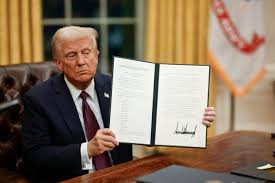The administration of former President Donald Trump implemented significant changes to the press’s access to the White House, drastically altering the model of presidential coverage that had been in place for decades. The first major application of this new policy occurred on Wednesday (26), when journalists from major news agencies, such as Reuters, Associated Press (AP), and other international outlets, were prevented from attending the first meeting of the new presidential cabinet.
The move sparked strong reactions from the journalism community, which views the decision as a potential attack on transparency and the press’s role in holding the government accountable. Among those barred were a photographer from the Associated Press and three reporters from Reuters, HuffPost, and the German newspaper Der Tagesspiegel, all of whom had traditionally been authorized to cover official White House events.

In contrast, the Trump administration allowed journalists and TV crews from outlets like ABC, Newsmax, Axios, Blaze, Bloomberg News, and NPR, raising questions about a potential favoring of media outlets ideologically aligned with the government.
On Tuesday (25), a day before the meeting, the Trump administration announced that the White House would directly select which outlets could access certain presidential spaces, such as the Oval Office and other smaller rooms within the official residence.
Until then, the selection of journalists had been made by the White House Correspondents’ Association, through a rotating system known as the press “pool.” This model, in place for decades, ensured that a small group of professionals from various media sectors—television, radio, print, photojournalism, and news agencies—could cover presidential events and share information with the rest of the national and international press.
The White House’s decision to break with this system is seen as an attempt to control the political narrative by restricting access to certain outlets that have previously clashed with the Trump administration.
The government’s decision caused widespread outrage among journalists, prompting three of the world’s leading news agencies—AP, Bloomberg, and Reuters—to issue a joint statement expressing concern over the White House’s new policy.
“News agencies play a crucial role in covering the U.S. presidency, providing accurate, impartial, and public interest information to millions of readers around the world,” the statement read.
“The reports produced by these agencies form the basis of global news coverage of the U.S. government, appearing in newspapers, websites, and television stations across different countries. It is essential for a democracy that the press have unrestricted access to the government, without interference that could compromise journalistic independence,” the statement emphasized.
HuffPost, one of the outlets blocked, called the decision a direct violation of the First Amendment-protected freedom of the press. The German newspaper Der Tagesspiegel, also prevented from covering the meeting, did not immediately respond to requests for comment.
The White House Correspondents’ Association, responsible for coordinating press access to the president for decades, also criticized the move, arguing that limiting the number of reporters allowed at White House events negatively affects government transparency and could be seen as an attempt to limit media oversight of the government.
Donald Trump’s relationship with the press has always been marked by tensions. During his first term, Trump frequently attacked journalists and media outlets, labeling those who criticized his administration as “fake news” and accusing them of spreading false information to harm him politically.
The exclusion of the Associated Press from covering the cabinet meeting followed a disagreement between the agency and the Trump administration. According to sources close to the administration, the decision to bar the AP was a direct retaliation for the agency’s refusal to adopt the term “Gulf of America”—a name Trump tried to impose on the Gulf of Mexico. The White House reportedly demanded that the AP revise its style guide to include this designation, but the agency refused, stating that its editorial policy follows international standards and cannot be influenced by political pressures.
This is not the first time Trump has imposed restrictions on media coverage of his administration. During his first term, there were several instances where journalists were barred from events, had their credentials revoked, or were publicly attacked by the president and his allies.
In 2018, for example, the White House suspended the credential of Jim Acosta, a CNN reporter, after a tense back-and-forth during a press conference with Trump. At the time, CNN sued the government and won a favorable ruling that forced the White House to restore Acosta’s credential.
Experts warn that the new access restriction policy could have serious consequences for independent journalism in the United States. By allowing only certain outlets to have direct access to the president and his cabinet, the White House could create an environment where only government-friendly information is released, undermining the public’s right to broad and balanced coverage.
The fact that outlets like Newsmax and Blaze, known for their favorable coverage of Trump, were allowed to participate in the event, while renowned agencies like AP and Reuters were excluded, raises suspicions of an ideologically motivated selection of the press.
Furthermore, constitutional law experts emphasize that restricting access for certain outlets could set a precedent for future administrations to implement even more restrictive policies, impacting press freedom in the United States in the long term.
The organization Reporters Without Borders (RSF) has already warned in previous reports about the deterioration of the relationship between the U.S. government and the press, classifying some of the measures taken during Trump’s presidency as attempts to weaken trust in the media.
In light of these concerns, journalists and press freedom advocacy organizations must continue monitoring the White House’s new guidelines, pushing for the maintenance of transparency and equitable access to government information.

